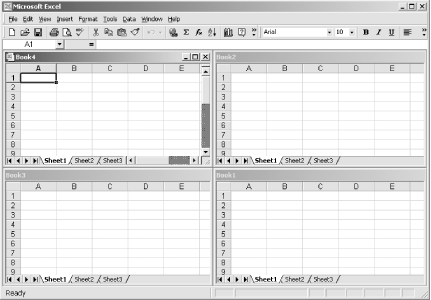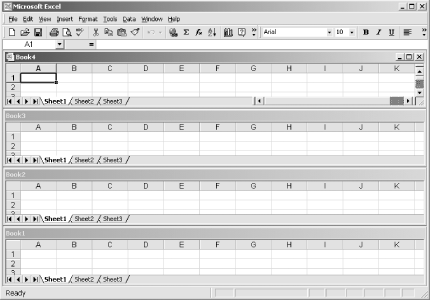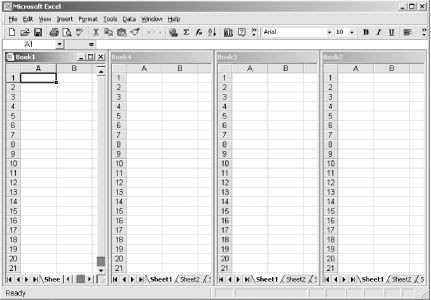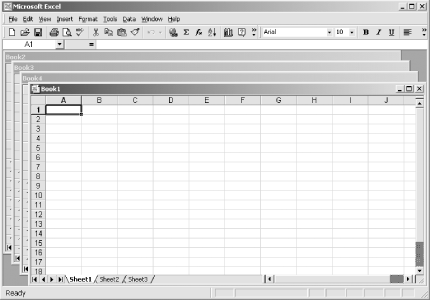|   Excel enables you to have multiple workbooks showing simultaneously , and to have a customized view of your workbooks arranged in different windows . Then you can save your view workspaces as .xlw files and use them when it suits you . Sometimes when working in Excel, you might need to have more than one workbook open on your screen. This makes it easier to use or view data from multiple workbooks. The next few paragraphs describe how to do this in a neat and organized way. Open all the workbooks you will need.  | To open more than one workbook at a time, select File  Open..., press the Ctrl key while selecting the workbooks you want to open, and then click Open. Open..., press the Ctrl key while selecting the workbooks you want to open, and then click Open. | |
From any of the workbooks (it doesn't matter which one), select Window  Arrange. If "Windows of active workbook" is checked, uncheck it, and then select the window arrangement you prefer and click OK. Arrange. If "Windows of active workbook" is checked, uncheck it, and then select the window arrangement you prefer and click OK. If you select Tiled, you will be presented with your workbooks in a tiled fashion, as shown with blank workbooks in Figure 1-1. Figure 1-1. Four workbooks in a tiled view  Selecting Horizontal gives you a view of your workbooks in a single stack, one on top of the other, as in Figure 1-2. Figure 1-2. Four workbooks in a horizontal view  Checking the Vertical option will place all your open workbooks side by side, as shown in Figure 1-3. Figure 1-3. Four workbooks in a vertical view  Finally, as shown in Figure 1-4, selecting the Cascade option will layer all your open workbooks one on top of the other. Figure 1-4. Four workbooks in a cascade view  Once your workbooks are displayed in your preferred view, you can easily copy, paste, drag-and-drop, etc., between them. If you think you might want to return to a view you created, you can save this preferred view as a workspace. To save a workspace, simply select File  Save Workspace, enter the workspace's filename in the File Name box, and click OK. When saving your workspace, the file extension will be .xlw rather than the standard .xls . To restore your Excel workspace to one full window of a particular workbook, just double-click the blue titlebar appearing on any one of your workbooks. You can also click the Maximize button on any of the windows in your workspace. Close your workbooks as usual when you're finished. Save Workspace, enter the workspace's filename in the File Name box, and click OK. When saving your workspace, the file extension will be .xlw rather than the standard .xls . To restore your Excel workspace to one full window of a particular workbook, just double-click the blue titlebar appearing on any one of your workbooks. You can also click the Maximize button on any of the windows in your workspace. Close your workbooks as usual when you're finished. Whenever you need to open those same workbooks, simply open the *.xlw file, and the view you initially set up will be magically restored for all workbooks. If you need to open just one of these workbooks, open the file as usual. Any changes you make to the workbooks in the *.xlw file will be saved automatically as you close the workspace as a whole, or you can save workbooks individually. If you spend a small amount of time setting up some custom views for repetitive tasks that require multiple open workbooks, you'll find that these tasks become easier to manage. You might decide to use different views for different repetitive tasks , depending on what the task is or how you're feeling that day. | 
 Open..., press the Ctrl key while selecting the workbooks you want to open, and then click Open.
Open..., press the Ctrl key while selecting the workbooks you want to open, and then click Open. 


